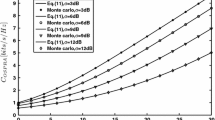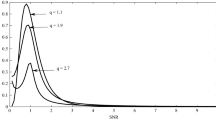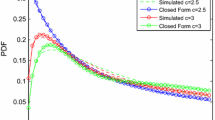Abstract
The statistical characterization of channel capacity in slow fading environment modeled by log-normal probability density function is considered. The probability density function of channel capacity is found to be positively skewed and significantly departs from bell shaped curve for higher values of σ dB . The computation of first two moments of channel capacity provides a measure for relative fluctuation in terms of coefficient of variation (CV). It is noted that the value of CV is quite high in lower range of SNR and starts declining with increasing SNR. This may question the applicability of average channel capacity as a performance measure in slow fading scenario and accordingly a more appropriate measure is based on outage capacity. A simple procedure based on three-point estimate is outlined to obtain the approximate expression for higher order moments of channel capacity and they are found to be in excellent agreement with exact results.
Similar content being viewed by others
References
Goldsmith A., Varaiya P. (1997) Capacity of fading channels with channel side information. IEEE Transaction on In Theory 43(6): 1986–1992
Lee W. C. Y. (1990) Estimate of chanel capacity in Rayleigh fading environment. IEEE Transactions on Vehicular Technology 93(3): 187–189
Alouni M. S., Goldsmith A. J. (1999a) Capacity of rayleigh fading channels under different adaptive transmission and diversity-combining techniques. IEEE Transactions on Vehicular Technology 48(4): 1165–1181
Sagias N. C., Tombras G. S., Karagiannidis G. K. (2005) New results for the Shannon channel capcity in geeneralized fading channels. IEEE Communication Letters 9(2): 97–99
Da Costa D. B., Yacoub M. D. (2007) Average channel capacity for generalized fading scearios. IEEE Communication Letters 11(12): 949–951
Goldsmith A. (2006) Wireless communications. Cambridge University Press, Cambridge
Le, K. N., & Dabke, K. P. Channel capacity of OFDM systems employing diversity in fading environments. Wireless Communications and Mobile Computing (in press). doi:10.1002/wcm.1078.
Simon M. K., Alouni M. S. (2000) Digital communication over fading channels: a unified approach to perfromance analysis. Wiley, London
Molisch A. F., Foerster J. R., Pendergrass M. (2003) Channel models for ultrawideband personal area networks. IEEE Wireless Communications Magazine 10(6): 14–21
Foerster, J., & et al. (2003). Channel modelling sub-committee report final. IEEE P802.15 Wireless Personal Area Networks, technical report. P802.15-02/490r1-SG3a.
Alouni M. S., Goldsmith A. J. (1999b) Area spectral efficiency of cellular mobile radio systems. IEEE Transactions on Vehicular Technology 48(4): 1047–1066
Laourine A., Stephenne A., Affes S. (2007) Estimating the ergodic capacity of log-norml channels. IEEE Communication Letters 11(7): 568–570
Laourine A., Stephenne A., Affes S. (2009) On the capacity of log-normal fading channels. IEEE Transaction on Communications 57(6): 1603–1607
Heliot F., Chu X., Hoshyar R., Tafazolli R. (2009) A tight closed-form approximation of the log-normal fading channel capacity. IEEE Transaction on Wireless Communications 8(6): 2842–2847
Biglieri E., Proakis J., Shamai S. (1998) Fading channels: Information-theoretic and communications aspects. IEEE Transactions on Information Theory 44(6): 2619–2692
Oyman, O., Nabar, R., Bolcskei, H., & Paulraj, A. (2002). Performance limits in fading MIMO channels. In Proceedings of IEEE fifth WMPC (Vol. 1, pp. 27–30).
Holtzman J. M. (1992) A simple, accurate method to calculate spread multiple-access error probabilities. IEEE Transactions on Communication 40: 461–464
Skraparlis D., Sakarellos V. K., Panangopoulos A. D., Kanellopoulos J. D. (2011) New results on the statistics and the capacity of dual-branch MRC and EGC diversity in correlated lognormal channels. IEEE Communication Letters 15(6): 617–619
Author information
Authors and Affiliations
Corresponding author
Rights and permissions
About this article
Cite this article
Karmeshu, Khandelwal, V. On the Applicability of Average Channel Capacity in Log-Normal Fading Environment. Wireless Pers Commun 68, 1393–1402 (2013). https://doi.org/10.1007/s11277-012-0529-2
Published:
Issue Date:
DOI: https://doi.org/10.1007/s11277-012-0529-2




